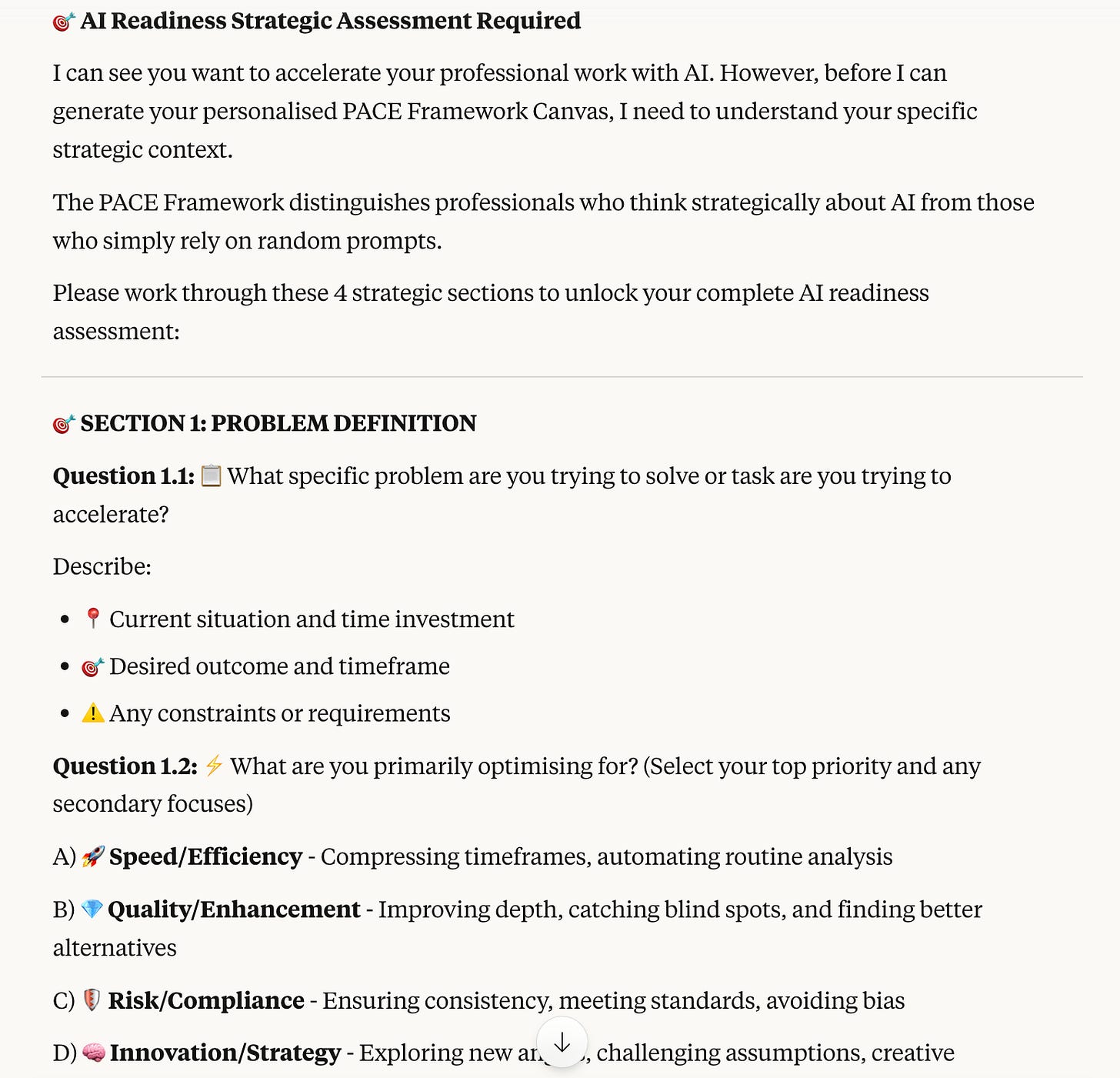AI Readiness: Create lightning-fast AI Agents with the PACE Framework
Transform scattered AI Agent experiments into strategic, job-relevant workflows while your colleagues are still figuring out what LLM platform to use.
Right then, let's have a proper look at where you actually stand with this AI business, shall we?
The "I'm Already AI-Ready" Delusion Check
Here's the thing that's doing my head in:
“Everyone's banging on about being "AI-ready" because they've had a few chats with ChatGPT and knocked out some meeting summaries.”
However, when it comes to actually identifying where AI fits into their ways of working (the aspects that move the needle), most professionals are unaware of their readiness level.
You're not AI-ready just because you can ask ChatGPT to write your emails with a prompt. That's like saying you're a mechanic because you can check your oil.
Real AI readiness means knowing when to reach for these tools, what problems they actually solve, and how to set yourself up for success before you even think about writing a prompt.
I often jump to Simon Sinek’s ‘Golden Circle’ to quickly address this.
The Readiness Check
Most product and transformation professionals I work with fall into the same trap:
They hear about someone using AI to ‘make workflow go faster’,
They immediately jump into writing prompts without asking the fundamental question, ‘Why do I need a prompt?’.
The reality is that AI readiness isn't about LLM mastery, it's about strategic thinking and what problem you're trying to solve, asking:
“Can you diagnose whether your problem is actually suitable for AI Agent assistance?”
“Do you understand what level of involvement you need to maintain with your AI Agent?”
“Can you identify the risks before the AI Agent bites you in the arse?”
Here's what separates the AI Agent builder pros from the pretenders:
Trait 1
Professionals who genuinely leverage AI effectively spend more time thinking about the problem setup than they do crafting the perfect prompt.
Trait 2
They've got a systematic approach to identifying when AI will genuinely accelerate their work versus when it'll just create more hassle.
Trait 3
They create scenarios of how they want to work with AI Agents. For example:
I’m a product strategist who spends typically two full days analysing competitor positioning, market gaps, and strategic recommendations. I want an AI Agent to condense this into a 10-minute analysis.
The question isn't whether an AI Agent can do this, it's whether you're ready to do this properly. Most people would immediately open ChatGPT and start dumping competitor data into a chat window.
However, the professionals who achieve transformative results follow a strategic framework.
The Pre-Prompt Strategy Framework
I’ve been testing an approach with clients who were convinced they were “AI-ready,” only to find they had no real structure for deciding how to use it.
The result was chaos. Over-delegating to the AI in some cases, and under-using it in others.
That’s why I built the PACE Framework. It’s the readiness lens I use before writing a single prompt, because if you don’t know your goal, your risk level, or how much authority you need to retain, you’ll never get predictable results.
Here’s how I use a Claude meta-prompt to help me with this.
How the PACE Prompt Works
Instead of rushing to answers, the prompt slows you down with a sequence of questions. Each section digs into what matters most:
Section 1: Problem - What task you’re tackling, your optimisation goal (speed, quality, risk, innovation), and your time compression target.
Section 2: Authority - The impact if things go wrong, who must sign off, and how much autonomy you’re willing to give the AI.
Section 3: Control - Where you insist on oversight—data quality, analysis, conclusions, compliance, etc.
Section 4: Execution - How you and the AI will split roles, how you’ll measure success, and what must appear in the final prompt.
By the end, you’ve clarified your context better than most teams do in a week of workshops.
Once you’ve completed the four sections, the prompt switches into Product Operations mode.
It generates this PACE Canvas with a consistent structure:
A readiness summary in simple outcome language.




